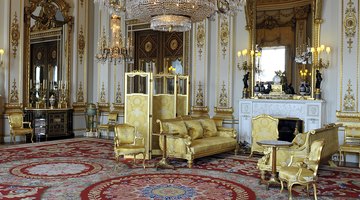The Difference Between a Drawing Room & a Withdrawing Room
Unlike modern homes where a room may serve multiple functions, Victorian society believed in giving each room a specific purpose and assigning specific activities of everyday life to a particular room. The wealthier the family, the more rooms were necessary to facilitate the activities of everyday life.

Less-affluent families allowed certain rooms to serve multiple purposes, and often a drawing room and a withdrawing room were one and the same.
Function
The withdrawing room was the predecessor of the drawing room. Withdrawing rooms were intended for the women of the house. At the conclusion of a dinner party, the ladies would withdraw to the withdrawing room for conversation, while the men remained in the dining room to discuss business affairs, drink and smoke. Women would play cards or board games, or they would entertain each other with music. In contrast, the drawing room was used to entertain guests during both the day and evening. Drawing rooms served as the social center of the house, but only for adults; children were usually prohibited from entering drawing rooms to keep them from accidentally breaking the decorations.
Decoration
Since the drawing room was used to entertain guests, extra energy and money was spent to make it as impressive as possible. Heavy curtains with elaborate fringe and trims, lush ferns in glass cases, delicate ceramic figurines and spindly chairs were many of the accoutrements found in Victorian drawing rooms. A fireplace was always present in this room, and the mantle was usually heavily festooned with decorations. Since the withdrawing room was used to entertain guests, money was spent on elegant decorations, but this room was much less elaborate than the drawing room.
Gender
The function of spaces in Victorian houses gave each room an implicit gender. The withdrawing room was a feminine space, since it was primarily inhabited by women and designed to physically shield their delicate sensibilities from the masculine activities of consuming alcohol, smoking cigars and discussing politics. The drawing room presents a struggle for Victorian scholars; the fussy decorations and focus on familial domesticity make the case that the drawing room was a feminine space, but other narratives must be considered. The drawing room was a public room to entertain both genders, and public spaces are identified with masculine ownership in Victorian studies. The decorations were also a way through which the man of the house demonstrated his earning prowess, putting a public face on the private sphere of the home.
Class
The number of rooms in a house and the ways in which a family used those rooms would indicate the social status of the occupants. Those with large houses would have a separate drawing room and withdrawing room, while middle- and lower-class families would also use the drawing room as their withdrawing room. A wealthy family might've used the drawing room once a week for formal entertainment, while the lower and middle classes would frequently gather for family pastimes in their drawing room. The wealthy used a separate space called the morning room for daily household activities and the back parlor for family meals, but a family with a small budget would use the drawing room for a morning room as well.
References
- "The Drawing-Room - Its Decorations and Functions"; Lucy Orrinsmith; 1878
- "A Gentle-woman's Home"; Jane Ellen Frith Panton; 1896
- Bricks and Brass: Social History
- "Femininity and Masculinity in Eighteenth Century Art and Culture"; Gillian Perry, et al.; 1993
- "Public Lives - Women, Family and Society in Victorian Britain"; Eleanor Gordon, et al.; 2003
Writer Bio
Hailing from California, Ann Mazzaferro is a professional writer who has written for "The Pacifican," "Calliope Literary Magazine" and presented at the National Undergraduate Literature Conference. Mazzaferro graduated magna cum laude with a Bachelor of Arts in English from the University of the Pacific.
Photo Credits
- WPA Pool/Getty Images Entertainment/Getty Images
- WPA Pool/Getty Images Entertainment/Getty Images
More Articles



